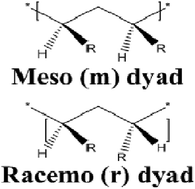Effect of polymer stereoregularity on polystyrene/single-walled carbon nanotube interactions
Abstract
We use a combination of computational and experimental studies to elucidate the effect of polymer stereoregularity on the capability of polystyrene interacting with single-walled carbon nanotube (SWNT) surfaces. Calculated binding energies on complexes of slightly oxidized SWNT with isotactic and atactic polystyrene favor the former, which suggests that the isotactic polymer interacts more effectively with the SWNT. The glass transition temperature (Tg) of the isotactic polystyrene/SWNT matrix increases from 90.9 to 100.5 °C as the SWNT content is increased to 0.5%, whereas the glass transition temperature of the atactic polystyrene/SWNT matrix is invariant with increasing SWNT content. Rotating frame 13C T1ρ relaxation rates for the isotactic polymer/SWNT matrix increases from 2.15 to 2.43 ms as the SWNT content is increased from 0.25 to 1.0%. However, the rotating frame 13C T1ρ relaxation rates for the atactic polymer/SWNT matrix decreases from 2.50 to 1.60 ms as SWNT content is increased from 0.25 to 1.0%. Our results demonstrate that the SWNTs are better dispersed within the isotactic polystyrene and the better dispersion is associated with a more effective interaction of the isotactic polymer with the SWNT surface.


 Please wait while we load your content...
Please wait while we load your content...